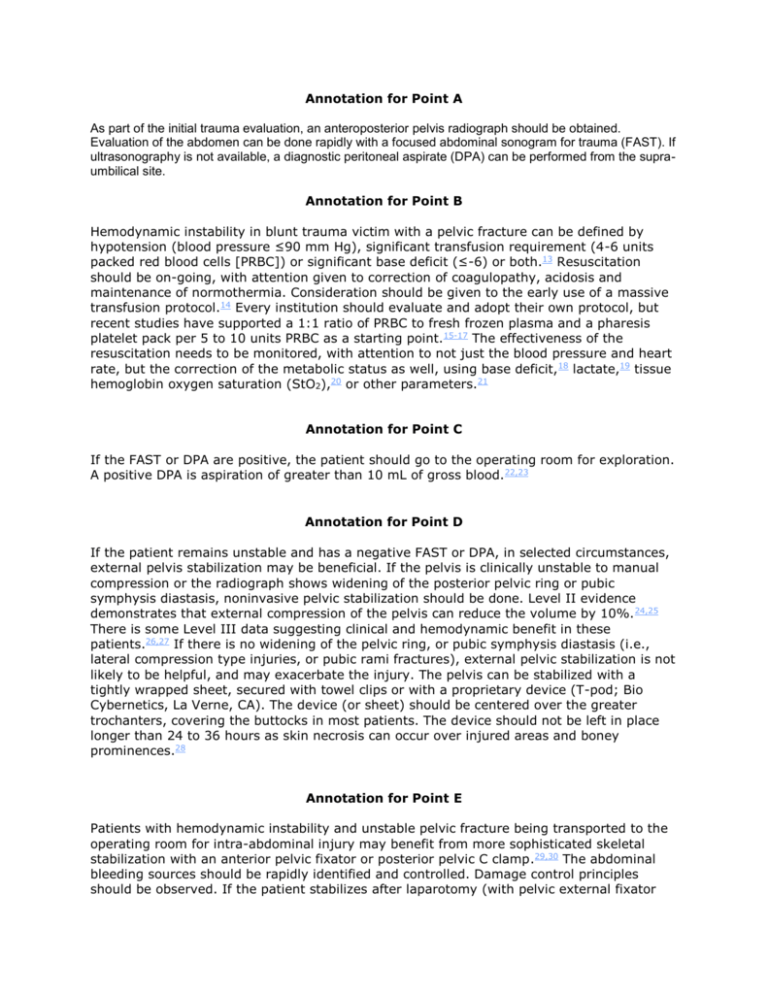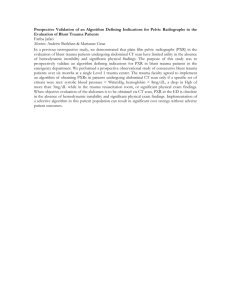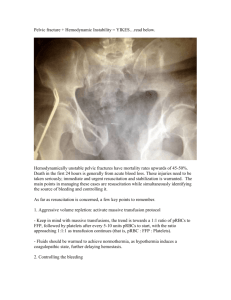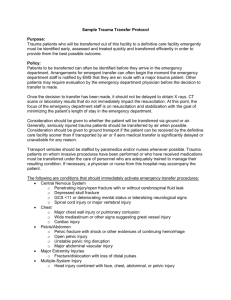Annotations - Western Trauma Association
advertisement

Annotation for Point A As part of the initial trauma evaluation, an anteroposterior pelvis radiograph should be obtained. Evaluation of the abdomen can be done rapidly with a focused abdominal sonogram for trauma (FAST). If ultrasonography is not available, a diagnostic peritoneal aspirate (DPA) can be performed from the supraumbilical site. Annotation for Point B Hemodynamic instability in blunt trauma victim with a pelvic fracture can be defined by hypotension (blood pressure ≤90 mm Hg), significant transfusion requirement (4-6 units packed red blood cells [PRBC]) or significant base deficit (≤-6) or both.13 Resuscitation should be on-going, with attention given to correction of coagulopathy, acidosis and maintenance of normothermia. Consideration should be given to the early use of a massive transfusion protocol.14 Every institution should evaluate and adopt their own protocol, but recent studies have supported a 1:1 ratio of PRBC to fresh frozen plasma and a pharesis platelet pack per 5 to 10 units PRBC as a starting point.15-17 The effectiveness of the resuscitation needs to be monitored, with attention to not just the blood pressure and heart rate, but the correction of the metabolic status as well, using base deficit, 18 lactate,19 tissue hemoglobin oxygen saturation (StO2),20 or other parameters.21 Annotation for Point C If the FAST or DPA are positive, the patient should go to the operating room for exploration. A positive DPA is aspiration of greater than 10 mL of gross blood. 22,23 Annotation for Point D If the patient remains unstable and has a negative FAST or DPA, in selected circumstances, external pelvis stabilization may be beneficial. If the pelvis is clinically unstable to manual compression or the radiograph shows widening of the posterior pelvic ring or pubic symphysis diastasis, noninvasive pelvic stabilization should be done. Level II evidence demonstrates that external compression of the pelvis can reduce the volume by 10%. 24,25 There is some Level III data suggesting clinical and hemodynamic benefit in these patients.26,27 If there is no widening of the pelvic ring, or pubic symphysis diastasis (i.e., lateral compression type injuries, or pubic rami fractures), external pelvic stabilization is not likely to be helpful, and may exacerbate the injury. The pelvis can be stabilized with a tightly wrapped sheet, secured with towel clips or with a proprietary device (T-pod; Bio Cybernetics, La Verne, CA). The device (or sheet) should be centered over the greater trochanters, covering the buttocks in most patients. The device should not be left in place longer than 24 to 36 hours as skin necrosis can occur over injured areas and boney prominences.28 Annotation for Point E Patients with hemodynamic instability and unstable pelvic fracture being transported to the operating room for intra-abdominal injury may benefit from more sophisticated skeletal stabilization with an anterior pelvic fixator or posterior pelvic C clamp.29,30 The abdominal bleeding sources should be rapidly identified and controlled. Damage control principles should be observed. If the patient stabilizes after laparotomy (with pelvic external fixator placement if appropriate); the patient should be transported to an intensive care setting for continued resuscitation. Annotation for Point F In patients with hemodynamic instability and refractory hemorrhagic shock, an alternative option, is direct transport to the operating room for preperitoneal packing. This approach should be used if the surgical team has the appropriate knowledge and experience to perform preperitoneal packing as described.3 If the pelvic hematoma is expanding or the patient remains unstable, exploration and preperitoneal packing should be rapidly performed.3,31 Preperitoneal packing is performed by opening the retroperitoneal hematoma anteriorly, and evacuating the blood and clot. The bladder is retracted laterally with a malleable retractor and the pelvic brim is carefully palpated and manually dissected. Care should be taken to avoid avulsing any vascular connections between the iliac and obturator vessels. After the pelvic brim is palpated as posteriorly as the surgeon can reach (it is not visualized), three laparotomy packs are placed sequentially deep to the pelvic brim. The first is placed posteriorly just below the sacro-iliac joint, the second sponge is placed anteriorly to the first (in the middle of the pelvic brim), and the third sponge is placed in the retropubic space, deep, and lateral to the bladder. When one side is completed, the bladder is retracted laterally toward that side and the other side is packed.31 If there is continued bright red hemorrhage indicative of arterial bleeding, emergency angiography with embolization should be performed. Removal or exchange of the packs (if bleeding persists after pack removal) should be performed in 24 to 48 hours. Annotation for Point G If the patient remains unstable after packing, urgent pelvic angiography with angioembolization should be performed. In one report of 18 patients who underwent emergency preperitoneal packing, 80% who had subsequent angiography had positive findings for arterial injury and underwent therapeutic embolization.32 Annotation for Point H If the abdominal evaluation is negative for free fluid and the patient remains unstable, urgent angiography and embolization should be performed. Miller et al. stratified patients with pelvic fracture and hypotension by response to resuscitation. Adequate response was defined by sustained improvement in blood pressure after transfusion of two units of PRBC or less. Those that did not respond to this level of resuscitation had positive angiography findings in 73%.9 Annotation for Point I In the setting of pelvic fracture related hemorrhage, an aortogram with bilateral runoff is followed by selective injections into both iliac systems. If extravasation of contrast is seen, documenting arterial bleeding, selective embolization with coils or foam should be performed. Evidence of vessel spasm, or abrupt cutoff of named vessels are also signs of injury and strong consideration should be given to embolization in those circumstances. This approach is reported successful in 87% in one study.33 A prospective study of angiography and embolization reports an 80% rate of embolization with pelvic and visceral angiography, with 95% effectiveness.34 If the patient stabilizes after angio-embolization, the patient should then get completion of the trauma evaluation including computed tomography (CT) scans and any needed plain radiographs. Annotation for Point J In patients that stabilize after angioembolization, the trauma evaluation should be completed including CT scans and any needed plain radiographs in the intensive care unit. Annotation for Point K If the patient remains unstable after angiography (particularly if there has not been therapeutic embolization), consideration should be given to urgent transport to the operating room and preperitoneal packing as described above for those patients that have not been to the operating room (F). Annotation for Point L A stable patient with a negative FAST or DPA or one that stabilizes with minimal resuscitation (sustained systolic blood pressure above 100 mm Hg, normalizing base deficit,18 decreased fluid requirement) can undergo CT scanning. If the CT reveals injury to the liver or spleen, nonoperative management protocols can be followed, if appropriate. Annotation for Point M A CT scan showing extravasation of contrast requires further intervention.35,36 The identification of contrast extravasation or blush on helical CT has been shown to have an accuracy of 98% for identifying patients requiring embolization.37 The site of extravasation corresponds to the site of bleeding at angiography and can serve to guide the interventional radiologist to the area of highest yield first.38 Annotation for Point N A stable patient with a CT scan that is negative, or does not require operative intervention, should go to an intensive care area for completion of resuscitation. This includes correction of coagulopathy and treatment for hypothermia. The patient should then get completion of the trauma evaluation including CT scans and any needed plain radiographs. Annotation for Point O One study of 556 patients undergoing pelvic angiography for suspected arterial hemorrhage had an embolization rate of 47%. Subsequently 42 (7.5% of the total population) had repeat angiography with embolization and successful hemorrhage control. 39 In one study of patients with complex pelvic fractures, not responding to subselective embolization, multiple sources of arterial hemorrhage were identified in 93%. Temporary embolization (with gelatin sponge slurry) of both internal iliac arteries was performed. This salvage maneuver was successful in 90% and with repeat embolization of both internal iliacs; a 97% success rate was achieved.40 Reported complications of bilateral internal iliac embolization have included gluteal skin and muscle necrosis with death from sepsis.41 References 1. Moreno C, Moore EE, Rosenberger A, Cleveland HC. Hemorrhage associated with major pelvic fracture: a multispecialty challenge. J Trauma. 1986;26:987-994. 2. Smith W, Williams A, Agudelo J, et al. Early predictors of mortality in hemodynamically unstable pelvis fractures. J Orthop Trauma. 2007;21:31-37. 3. Cothren CC, Osborn PM, Moore EE, Morgan SJ, Johnson JL, Smith WR. Preperitonal pelvic packing for hemodynamically unstable pelvic fractures: a paradigm shift. J Trauma. 2007;62:834-839; discussion 839-842. 4. Gilliland MD, Ward RE, Barton RM, Miller PW, Duke JH. Factors affecting mortality in pelvic fractures. J Trauma. 1982;22:691-693. 5. Balogh Z, Caldwell E, Heetveld M, et al. Institutional practice guidelines on management of pelvic fracture-related hemodynamic instability: do they make a difference? J Trauma. 2005;58:778-782. 6. Biffl WL, Smith WR, Moore EE, et al. Evolution of a multidisciplinary clinical pathway for the management of unstable patients with pelvic fractures. Ann Surg. 2001;233:843-850. 7. Pohlemann T, Bosch U, Gansslen A, Tscherne H. The Hannover experience in management of pelvic fractures. Clin Orthop Relat Res. 1994;69-80. 8. Huittinen VM, Slatis P. Postmortem angiography and dissection of the hypogastric artery in pelvic fractures. Surgery. 1973;73:454-462. 9. Miller PR, Moore PS, Mansell E, Meredith JW, Chang MC. External fixation or arteriogram in bleeding pelvic fracture: initial therapy guided by markers of arterial hemorrhage. J Trauma. 2003;54:437-443. 10. Ben-Menachem Y, Coldwell DM, Young JW, Burgess AR. Hemorrhage associated with pelvic fractures: causes, diagnosis, and emergent management. AJR Am J Roentgenol. 1991;157:1005-1014. 11. Cryer HM, Miller FB, Evers BM, Rouben LR, Seligson DL. Pelvic fracture classification: correlation with hemorrhage. J Trauma. 1988;28:973-980. 12. Murr PC, Moore EE, Lipscomb R, Johnston RM. Abdominal trauma associated with pelvic fracture. J Trauma. 1980;20:919-923. 13. Davis JW, Parks SN, Kaups KL, Gladen HE, O'Donnell-Nicol S. Admission base deficit predicts transfusion requirements and risk of complications. J Trauma. 1996;41:769-774. 14. Malone DL, Hess JR, Fingerhut A. Massive transfusion practices around the globe and a suggestion for a common massive transfusion protocol. J Trauma. 2006;60:S91-S96. 15. Sperry J, Ochoa J, Gunn S, et al. FFP:PRBC ratio of 1:1 is associated with significant lower risk of mortality following massive transfusion [abstract]. J Trauma. 2008;64:247. 16. Gonzalez EA, Jastrow E, Holcomb JB, Kao LS, Moore FA, Kozar RA. Early achievement of a 1:1 ratio of FFP:PRBC reduces mortality in patients receiving massive transfusion [abstract]. J Trauma. 2008;64:247. 17. Ketchum L, Hess JR, Hiippala S. Indications for early fresh frozen plasma, cryoprecipitate, and platelet transfusion in trauma. J Trauma. 2006;60:S51-S58. 18. Davis JW, Kaups KL, Parks SN. Base deficit is superior to pH in evaluating clearance of acidosis after traumatic shock. J Trauma. 1998;44:114-118. 19. Abramson D, Scalea TM, Hitchcock R, Trooskin SZ, Henry SM, Greenspan J. Lactate clearance and survival following injury. J Trauma. 1993;35:584-588; discussion 588-589. 20. Moore FA, Nelson T, McKinley BA, et al. Massive transfusion in trauma patients: tissue hemoglobin oxygen saturation predicts poor outcome. J Trauma. 2008;64:1010-1023. 21. Tisherman SA, Barie P, Bokhari F, et al. Clinical practice guideline: endpoints of resuscitation. J Trauma. 2004;57:898-912. 22. Sugrue M. Diagnostic peritoneal aspiration (DPA) and diagnostic peritoneal lavage (DPL). In: D'Amours SK, Sugrue M, Russell R, Nocerra N, eds. Liverpool Hospital Trauma Manual. Sydney, Australia: Liverpool Hospital; 2002. 23. Mendez C, Gubler KD, Maier RV. Diagnostic accuracy of peritoneal lavage in patients with pelvic fractures. Arch Surg. 1994;129:477-481; discussion 481-482. 24. Bottlang M, Simpson T, Sigg J, Krieg JC, Madey SM, Long WB. Noninvasive reduction of open-book pelvic fractures by circumferential compression. J Orthop Trauma. 2002;16:367373. 25. Krieg JC, Mohr M, Ellis TJ, Simpson TS, Madey SM, Bottlang M. Emergent stabilization of pelvic ring injuries by controlled circumferential compression: a clinical trial. J Trauma. 2005;59:659-664. 26. Nunn T, Cosker TD, Bose D, Pallister I. Immediate application of improvised pelvic binder as first step in extended resuscitation from life-threatening hypovolaemic shock in conscious patients with unstable pelvic injuries. Injury. 2007;38:125-128. 27. Routt ML, Falicov A Jr, Woodhouse E, Schildhauer TA. Circumferential pelvic antishock sheeting: a temporary resuscitation aid. J Orthop Trauma. 2002;16:45-48. 28. Jowett AJ, Bowyer GW. Pressure characteristics of pelvic binders. Injury. 2007;38:118121. 29. Ertel W, Keel M, Eid K, Platz A, Trentz O. Control of severe hemorrhage using C-clamp and pelvic packing in multiply injured patients with pelvic ring disruption. J Orthop Trauma. 2001;15:468-474. 30. Archdeacon MT, Hiratzka J. The trochanteric C-clamp for provisional pelvic stability. J Orthop Trauma. 2006;20:47-51. 31. Smith WR, Moore EE, Osborn P, et al. Retroperitoneal packing as a resuscitation technique for hemodynamically unstable patients with pelvic fractures: report of two representative cases and a description of technique. J Trauma. 2005;59:1510-1514. 32. Totterman A, Madsen JE, Skaga NO, Røise O. Extraperitoneal pelvic packing: a salvage procedure to control massive traumatic pelvic hemorrhage. J Trauma. 2007;62:843-852. 33. Panetta T, Sclafani SJ, Goldstein AS, Phillips TF, Shaftan GW. Percutaneous transcatheter embolization for massive bleeding from pelvic fractures. J Trauma. 1985;25:1021-1029. 34. Velmahos GC, Toutouzas KG, Vassiliu P, et al. A prospective study on the safety and efficacy of angiographic embolization for pelvic and visceral injuries. J Trauma. 2002;53:303-308; discussion 308. 35. Ochsner MG. Factors of failure for nonoperative management of blunt liver and splenic injuries. World J Surg. 2001;25:1393-1396. 36. Omert LA, Salyer D, Dunham CM, Porter J, Silva A, Protetch J. Implications of the contrast blush finding on computed tomographic scan of the spleen in trauma. J Trauma. 2001;51:272-277; discussion 277-278. 37. Pereira SJ, O'Brien DP, Luchette FA, et al. Dynamic helical computed tomography scan accurately detects hemorrhage in patients with pelvic fracture. Surgery. 2000;128:678-685. 38. Yoon W, Kim JK, Jeong YY, Seo JJ, Park JG, Kang HK. Pelvic arterial hemorrhage in patients with pelvic fractures: detection with contrast-enhanced CT. Radiographics. 2004;24:1591-1605; discussion 1605-1606. 39. Gourlay D, Hoffer E, Routt M, Bulger E. Pelvic angiography for recurrent traumatic pelvic arterial hemorrhage. J Trauma. 2005;59:1168-1173; discussion 1173-1174. 40. Velmahos GC, Chahwan S, Hanks SE, et al. Angiographic embolization of bilateral internal iliac arteries to control life-threatening hemorrhage after blunt trauma to the pelvis. Am Surg. 2000;66:858-862. 41. Suzuki T, Shindo M, Kataoka Y, et al. Clinical characteristics of pelvic fracture patients with gluteal necrosis resulting from transcatheter arterial embolization. Arch Orthop Trauma Surg. 2005;125:448-452.







